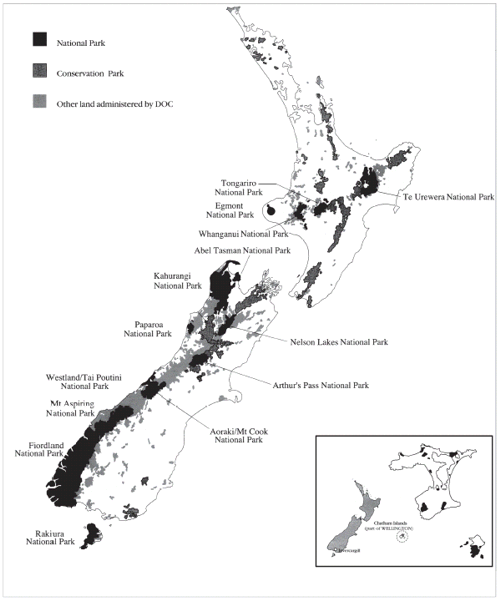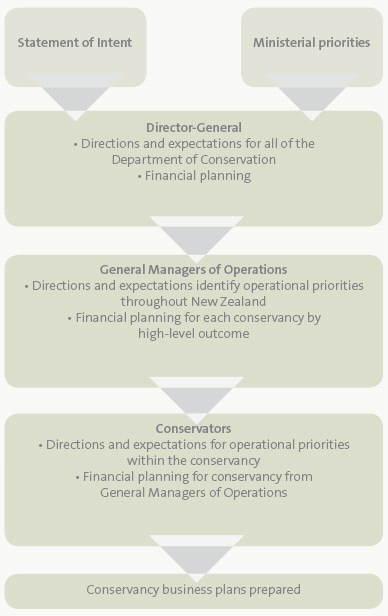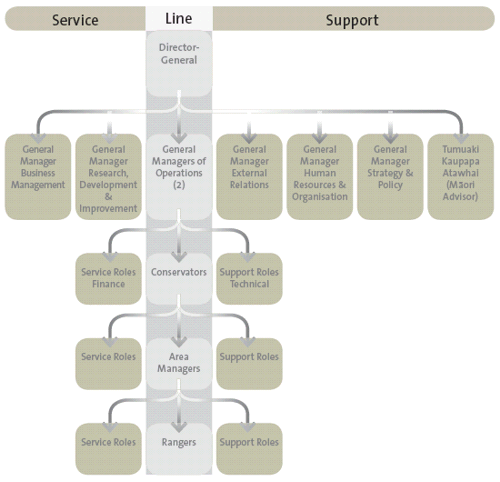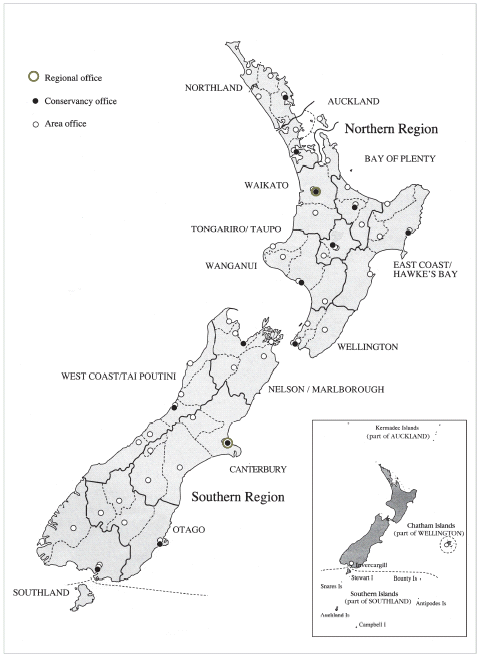Part 2: Department of Conservation and its land planning and management frameworks
2.1
In this Part, we describe:
- the Department of Conservation’s legislative responsibilities for land;
- the location and classifications of the land it manages;
- the statutory planning framework for the land;
- the management framework for the land; and
- how the Department of Conservation is organised to work within those frameworks.
Legislative responsibilities for land
2.2
The Conservation Act 1987 set up the Department. Under section 6 of the Act, the Department is to –
… manage for conservation purposes, all land, and all other natural and historic resources, for the time being held under this Act, and all other land and natural and historic resources whose owner agrees with the Minister that they should be managed by the Department.
2.3
Legislation also requires the Department to:
- advocate conserving natural and historic resources;
- promote the benefits to present and future generations of conservation of natural and historic resources;
- prepare, provide, distribute, promote, and publicise conservation information; and
- foster recreation and allow tourism, to the extent that the use of any natural and historic resource is not inconsistent with its conservation.
2.4
The Department has statutory responsibilities to prepare and review policies, strategies, and plans for land. The Department also has several statutory responsibilities in managing land. The relevant Acts for this report are the Conservation Act 1987, the National Parks Act 1980, the Reserves Act 1977, and the Wildlife Act 1953.
Publicly owned land managed by the Department of Conservation
2.5
The location of the more than 8.5 million hectares of publicly owned land that the Department manages is shown in Figure 1.
Figure 1
Publicly owned land managed by the Department of Conservation

Classification of the land managed by the Department of Conservation
2.6
The Department manages land under classifications set by legislation. Land classifications identify the general purpose for which parks, areas, sanctuaries, refuges, and reserves are to be managed.
2.7
Land classified under the Conservation Act 1987 accounts for about 55% of the area managed by the Department. It includes conservation parks, wilderness areas, ecological areas, sanctuary areas, watercourse areas, amenity areas, wildlife management areas, and stewardship areas.
2.8
Land classified under the National Parks Act 1980 accounts for about 36% of the land area managed by the Department. It includes national parks and areas that can be further classified within national parks, including specially protected areas, wilderness areas, and amenities areas.
2.9
Land classified under the Reserves Act 1977 accounts for about 8% of the land area managed by the Department. It includes reserves for recreation, historic, scenic, natural, scientific, and government purposes.
2.10
Land classified under the Wildlife Act 1953 accounts for less than 1% of the land area managed by the Department. It includes wildlife sanctuaries, wildlife refuges, and wildlife management reserves.
Statutory planning framework for land
2.11
The statutory planning framework directs how the Department manages land. There is a hierarchy of statutory policies, strategies, and plans. The hierarchy includes statements of general policy, conservation management strategies, conservation management plans, and management plans for national parks (see Figure 2).
Figure 2
Statutory planning framework for land

Statements of general policy
2.12
The Department is responsible for preparing statements of general policy. The purpose of statements of general policy is to provide the Department with direction and guidance for managing land. Preparing statements of general policy is not compulsory, but is provided for under the Conservation Act 1987 and the National Parks Act 1980.
2.13
The Department has a new Conservation General Policy (May 2005), and revised General Policy for National Parks (April 2005). Although they are separate documents, the 2 statements of general policy are closely related. This is because of common administration by the Department, shared boundaries between national parks and other conservation lands and waters, and movement of species between different places that occurs regardless of land status.
2.14
The Conservation General Policy outlines policies on the purpose and content of conservation management strategies, and on gaining, disposing of, exchanging, or reviewing the classification of public lands. The General Policy for National Parks outlines policies on the purpose and content of national park management plans, new national parks, additions to national parks, boundaries, and special areas within national parks.
Conservation management strategies
2.15
The purpose of conservation management strategies is to carry out statements of general policy, and to set up objectives for the integrated management of natural and historic resources, and for recreation, tourism, or other conservation purposes. The National Parks Act 1980 requires conservation management strategies to set up management objectives for any national parks within the area covered by the strategies. The Department must prepare conservation management strategies, and review them within 10 years of their approval by the New Zealand Conservation Authority.
Conservation management plans
2.16
The purpose of conservation management plans is to carry out conservation management strategies, and to set up detailed objectives for the integrated management of natural and historic resources within areas managed by the Department under various Acts, and for recreation, tourism, and other conservation purposes. Preparing conservation management plans is not compulsory, unless a conservation management strategy specifically requires them.
National park management plans
2.17
The purpose of national park management plans is to provide for managing a national park in keeping with the National Parks Act 1980. National park management plans must be prepared within 2 years of a national park being constituted, and plans must be reviewed within 10 years of being approved.
2.18
The Act does not require specific management objectives to be contained in national park management plans. However, the Act sets out the purpose for which national parks are created, and this provides direction for park management. Under the Act, national park management plans must not be inconsistent with the terms of any relevant conservation management strategy.
The Department of Conservation’s land management framework
2.19
The Department’s land management framework guides how the Department manages the publicly owned land it is responsible for. The land management framework includes processes and procedures supporting the Department’s strategic direction, accountability systems, and guidance.
Strategic direction
2.20
The Statement of Intent 2005-2008 (the Statement of Intent) outlines the Department’s strategic direction, and sets out 2 inter-related high-level outcomes:
- Protection – “New Zealand’s natural and historic heritage is protected and restored.”
- Appreciation – “People enjoy and benefit from New Zealand’s natural and historic heritage and are connected with conservation.”
2.21
The high-level outcomes of the Statement of Intent are supported by a series of national strategic plans and operational and technical plans that provide direction and guidance for planning and initiatives within the Department.
2.22
The high-level outcomes of the Statement of Intent are also supported by the directions and expectations conveyed by the Director-General to line managers. The Director-General’s directions and expectations are set out yearly. The 2 General Managers of Operations use these to set their priorities, which in turn are used to prepare business plans for each conservancy. Figure 3 shows how directions and expectations are used, with indicative budgets, to prepare conservancy business plans.
Figure 3
Using directions and expectations to prepare conservancy business plans

2.23
We discuss the link between conservancy business plans and statutory planning documents in paragraphs 4.16-4.21.
Accountability systems
2.24
The Department has several accountability systems to co-ordinate and direct its operations, including:
- a delegations framework;
- organisational performance reviews against strategic directions;
- planning and performance reviews on individual performance;
- and annual financial and non-financial reporting.
Guidance
2.25
The Department has a set of guidance material, or standard operating procedures, that staff are expected to follow when they are doing particular types of work, including statutory land management. Standard operating procedures are prepared to achieve consistency, agreed standards, clearly accountable actions, legal compliance, and formally agreed best practice for different types of work. There are standard operating procedures for disposing of, exchanging, gazetting, checking, and revoking land and its status.
How the Department of Conservation is organised to work within these frameworks
2.26
Staff within the Department are organised in 3 role groups – line management, support, and service. Line management roles provide leadership and direction. Support and service roles provide technical, community relations, business support, and service functions to the line management roles. Line management roles include the Director-General, General Managers of Operations, Conservators, Area Managers, and Rangers. Figure 4 shows the Department’s organisational structure.
Figure 4
The Department of Conservation’s organisational structure

2.27
The Department has a Head Office based in Wellington, 2 Regional Offices in Hamilton and Christchurch, and 13 conservancies throughout the country. The conservancies support a network of local Area Offices within each conservancy. Figure 5 shows conservancy boundaries, and the locations of Conservancy, Regional, and Area Offices.
Figure 5
Conservancy boundaries and Office locations

2.28
The Department’s organisational structure is decentralised. Fieldwork and operations are delivered from Area Offices, with Conservancy Offices providing technical support and advice, and ensuring accountability.
2.29
Regional Offices provide leadership and are accountable for operational work in their regions. The Department’s Head Office prepares national policies, provides leadership, and provides national service and support work.

